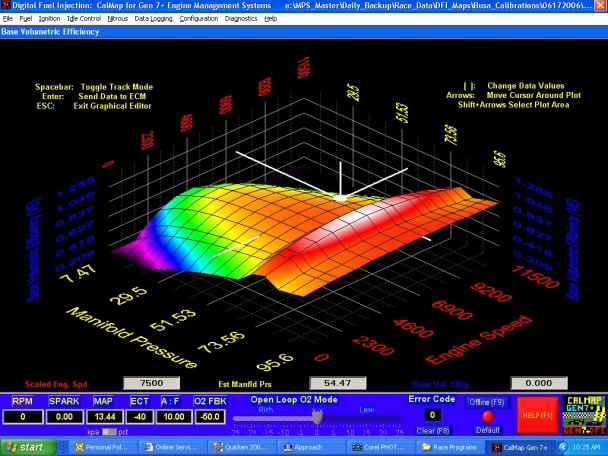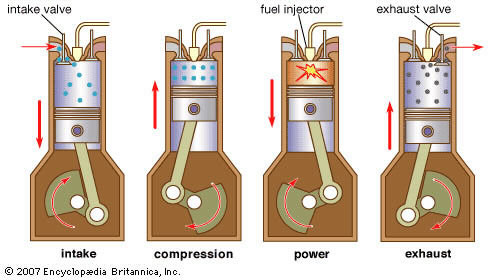Fuel Map or Fuel Table
Modern automotive technology relies on electronically controlled devices to monitor and operate the car’s engine. An important process that determines the performance of the engine is the fuel injection process. Fuel injection is the process that causes combustion in an engine by combining fuel and air.
In the past, internal combustion engines used carburetors to mix the fuel and air. As cars became more complex and government regulations related to exhaust emissions became stricter, today’s engines use computer controlled systems with electronic fuel injection which can more precisely control the flow of fuel to the engine, allowing for precise mixing of fuel and air. This results in optimum engine performance, better fuel economy, and lower exhaust emissions, or more power and torque, depend what you want. The efficiency and precision of the fuel injection system will also determine how well the engine runs and ultimately how well the car performs.
Gas pedal is no longer a simple way of directly moving the throttles on the engine, because the ECU replaced traditional Bowden cable between the pedal and throttle with pedal position sensor and a map. Such maps are now restricted to tire type, so just three maps are allowed: for wet weather, intermediate and dry tires. Previously, different maps could be selected for the race start and other race situations. The regulations also enforce other restrictions on the pedal, for example no detents or other means can be used to aid the driver in holding a specific position, such as holding revs steady at the race start.
5.5 Power unit torque control :
5.5.4 The accelerator pedal shaping map in the ECU may only be linked to the type of the tyres fitted to the car : one map for use with dry-weather tyres and one map for use with intermediate or wet-weather tyres.
The fuel map is the electronic fuel injection system's setting for regulating the air/fuel mix and is created by engineers during construction and tests of an engine. Fuel map is not a peace of paper, but an engine computer sets of settings. You can imagine a fuel map as a graph paper with an X and Y axis on it. X axis is one going horizontally from left to and one Y axis going up and down. The numbers along the X axis represent the engine's revolutions per minute (rpm), and numbers on Y axis represents the load on the engine, or the energy required by the engine to do the task required by the driver. Now, if you can imagine a lot of points scattered all around that graph paper that represent different driving situations, you will get a fuel map. At each point, and there are hundreds of possible combinations, the ECU decides what to tell the fuel injectors to do at some specific situation and combination of RPM-s and torque demand. This is only simplified explanation to give you an idea. Normally, in any modern fuel injected engine, the ECU uses a numerical map, or 3 dimensional graphical map to determine how much fuel to give, and how much advancement in ignition timing. A typical fuel map looks like this:
 |
Graphical 3D fuel map |
The axis on the right is RPM. The axis on the left is engine load. For naturally aspirated engines, the engine load is typically the same as your TPS (throttle positioning sensor) reading, which is essentially how much gas pedal you give it. With pedal position changed, manifold pressure is changed and measured in Kg/cm2. For turbo or other force induction engines, the engine load is typically the same as your Manifold Absolute Pressure (MAP) reading, which is the vacuum or boost pressure of your engine. The mountain you see is how much fuel the ECU is giving the engine, or Volumetric efficiency.
 |
Numerical fuel map |
In this picture you can see typical numerical two dimensional map for 1995 Mitsubishi 3000GT VR4 Spyder, with load (torque) in vertical axis and RPM-s in horizontal axis. Numbers represents duration of open injector or actual consumption. When choosing a value from any of the fuel or ignition tables, the ECU interpolates between the currently used cell and surrounding cells to ensure smoothness. In a fuel map, fuel consumption (g/kWh or g/s) is expressed as a function of engine speed and engine torque.
Fuel maps are covering the whole engine working area with engine speed from idling up to the maximum RPM-s and with torque from full engine braking, negative torque, up to full load and the main purpose is to tune the engine for all sort of different situations and allow it to run at its optimum level and at its highest potential at each possible variation of load and RPM.

Tuning the engine to achieve maximum efficiency is a huge part of getting the best performance out of the race cars. Making adjustments to the fuel injection system to change the amount of fuel and injections time, and utilizing many available engine sensors can all have a great impact on engine horsepower and efficiency.
Sensors located in the engine and throughout the rest of the vehicle send information to the ECU. The ECU interprets this information and uses it to keep the car working at its best. For example, the ECU uses the oxygen sensor in conjunction with the pre programmed fuel tables to calculate how much fuel is needed for your engine. Also, ECU looks through the tables and, depending on engine speed and intake manifold vacuum, selects a length of time that the injectors will stay open. There are a more sensors involved in creating and deploying a fuel map. For example Mass Air Flow (MAF) Sensor measures the amount of air coming into the engine. Less air is drawn into the engine when it's idling, so less fuel is needed, and opposite, when engine is on higher RPM-s more fuel is needed from the injectors. Oxygen (O2) Sensor is located in the exhaust system and detects the amount of unburned oxygen so ECU can adjust the amount of fuel injected into the engine to burn all available oxygen and increase efficiency. Throttle Position Sensor (TPS) tells the computer how hard driver pushes on the gas pedal. The farther and faster the pedal is pushed, the wider open the throttle moves, increasing the amount of fuel that needs to be added to the engine for speed. Manifold Absolute Pressure (MAP) Sensor measures changes in the engine's manifold pressure, which tells the ECU how much load the engine needs to bear (towing or going uphill or downhill) and how fast it needs to happen (speeding up or slowing down). If the sensor reads high pressure, the ECU will lower the engine vacuum and add more fuel. If there is low pressure, the ECU will raise the vacuum and reduce the fuel injection. Last bun not least, there is a Vehicle Speed Sensor (VSS) which tells the ECU how fast the car is moving to adjust the fuel accordingly. The fuel map inside the ECU is able to adjust the air/fuel mix for maximum efficiency and performance in any condition as long as the sensors are giving it the right information.
All of the above sensors and parameters are controlled by the car’s ECU. The ECU have an incorporated fuel injection control systems (driver) which sends signals to the fuel injectors, indicating when to open and how long to remain open in order to reach the maximum efficiency. The fuel is added to the air mixture at the latest possible time (right before combustion). The ideal air to fuel ratio, called the stoichiometric value, is 14.68 parts air to one part fuel (AFR is 14.68:1 by mass). This is the ratio of air to fuel that allows the oxygen and fuel to burn completely. However, conditions are never ideal so the most efficient AFR depends on the temperature, the engine’s rpm, and the load on the engine (how much work the engine is doing). So, ECU receives and process data from many sensors in order to make constant small corrections so the engine’s ability is optimized. The ECU also sends a signal to the spark coil so that it sparks at exactly the right time to ignite the fuel (more or less when compression within the cylinder is greatest). The spark coil generates high voltage needed for the spark to initiate, causing the spark in the spark plugs, which in turn ignite the fuel-air mixture.
Using this data, different tables including volumetric efficiency and ignition advance can be created and adjusted to reach maximum horsepower.
Fuel injection mapping really is the process of systematically adjusting the fuel/air ratio at all operating points of the engine at specifics situations. The car user could have one of many goals. For normal user concern could be emissions, fuel economy, or some compromise between balance of performance, emissions and noise. For racing it would be no compromise, only power. At the track we are only tuning for power and torque. The mapping results would be very different.
To know more about mapping, check my other articles:
Back to the top of the page






